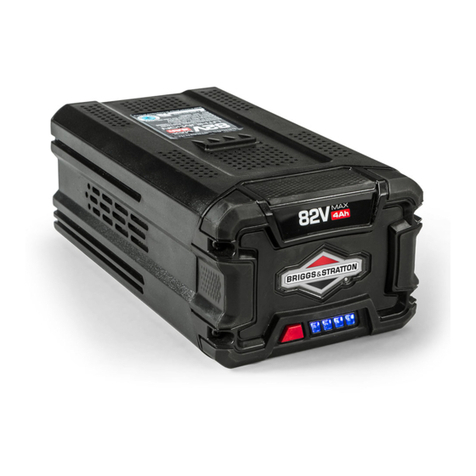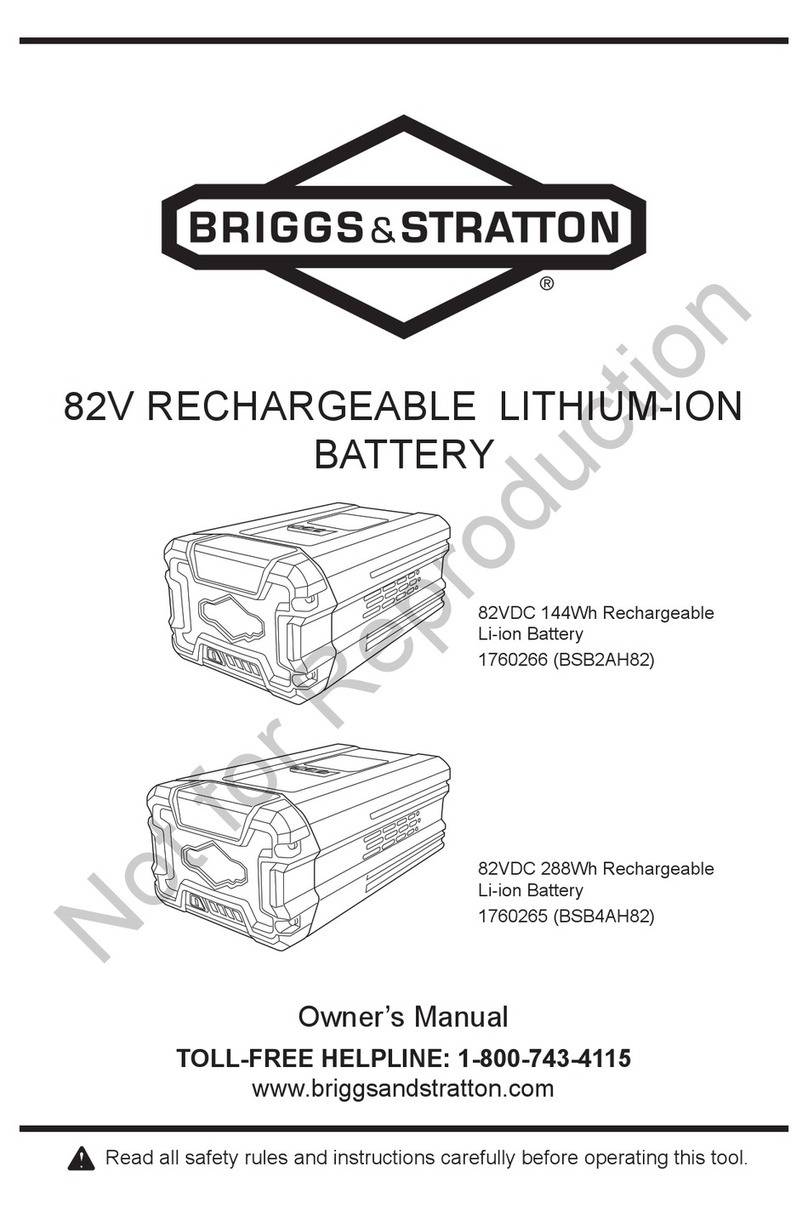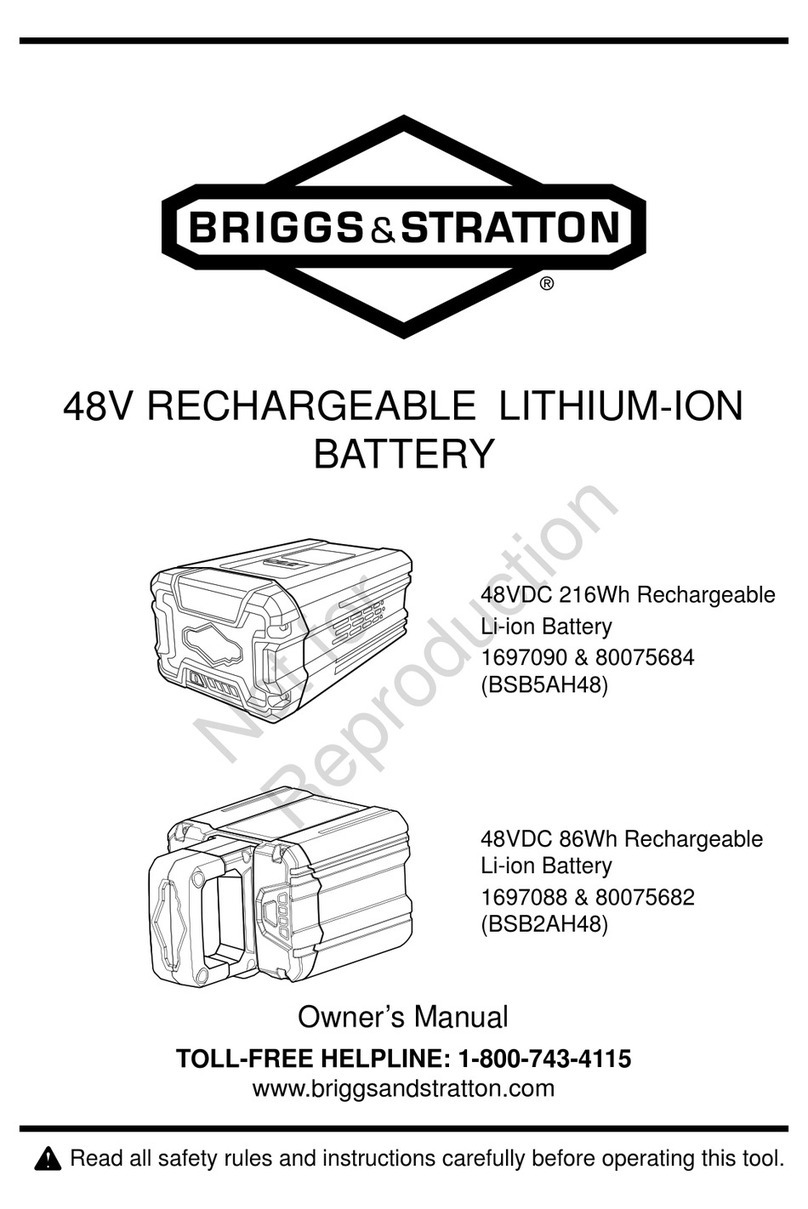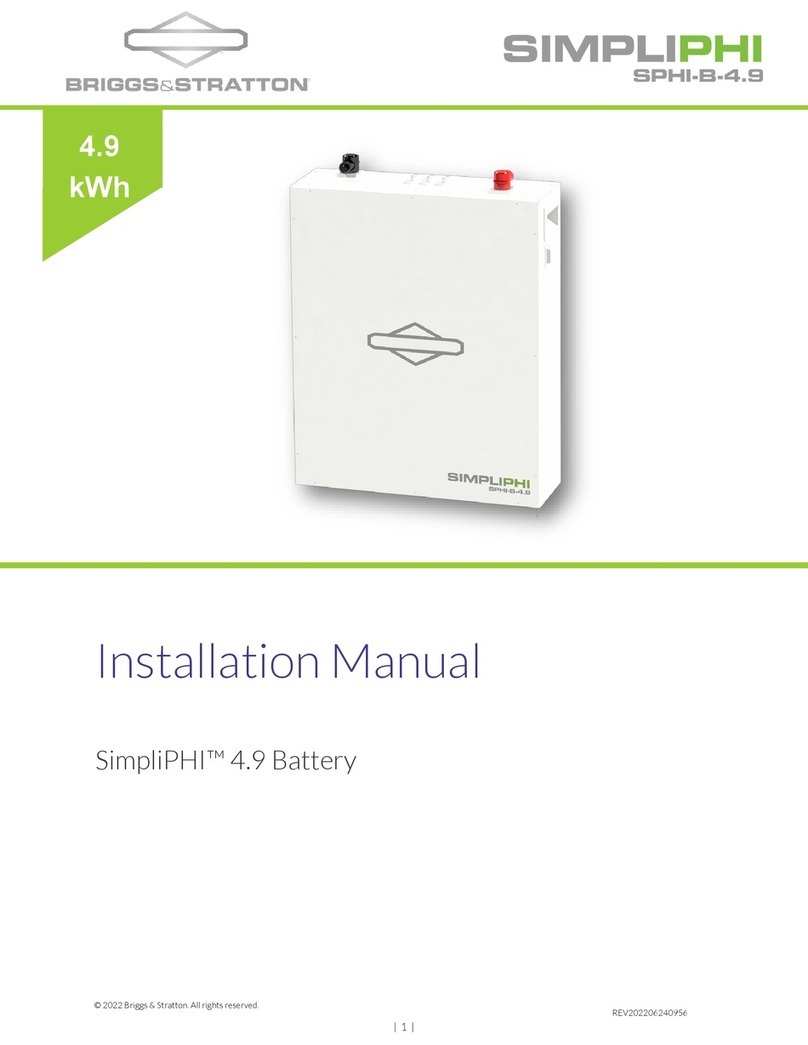
Top Voltage 58.8V
Cut-off Voltage 35.0V
Discharge Temperature
Range
-4 °F to +140 °F (-20 °C to 60 °C)
Storage Temperature 1
month
-4 °F to +140 °F (-20 °C to +60 °C)
Storage Temperature 1 year -4 °F to +77 °F (-20 °C to +25 °C )
*Charging Temperature
Range
14 °F to 113 °F ( -10 °C to 45 °C)
Maximum Heat Exposure 158 °F (70 °C)
**Minimum IPX Rating IP56+ Pressure Wash
Battery Terminal Torque 55 in-lb (6.21 Nm)
Hazardous Material
Classification
Class 9
*Charging temperature rangescanchangebecause ofthe configuration of the
equipment where the battery is installed.
** A higher IPX Rating may be achieved with certain battery configurations.
Compliance
FCCCompliant
Pursuant to part 15.21 of the FCC Rules, you are cautioned that changes
or modifications to the product not expressly approved by Briggs & Stratton
could void your authority to operate the product.
This device complies with part 15 of the FCC Rules.
Operation is subject to the following two conditions: (1) This device may not
cause harmful interference, and (2) this device must accept any interference
received, including interference that may cause undesired operation.
This equipment has been tested and found to comply with the limits for
a Class B digital device, pursuant to part 15 of the FCC Rules. These
limits are designed to provide reasonable protection against harmful
interference in a residential installation. This equipment generates, uses
and can radiate radio frequency energy and, if not installed and used in
accordance with the instructions, may cause harmful interference to radio
communications. However, there is no guarantee that interference will
not occur in a particular installation. If this equipment does cause harmful
interference to radio or television reception, which can be determined by
turning the equipment off and on, the user is encouraged to try to correct
the interference by one or more of the following measures:
• Reorient or relocate the receiving antenna.
• Increase the separation between the equipment and receiver.
• Connect the equipment into an outlet on a circuit different from that to
which the receiver is connected.
• Consult the dealer or an experienced radio/TV technician for help.
Vanguard® Battery Warranty
Effective June 2022
Limited Warranty
Briggs & Stratton warrants that, during the warranty period
specified below, it will repair or replace, free of charge,
with a new, reconditioned or re-manufactured part, at
the sole discretion of Briggs & Stratton, any part that is
defective in material or workmanship or both. Transportation
charges on product submitted for repair or replacement
under this warranty must be borne by purchaser. This
warranty is effective for and is subject to the time periods
and conditions stated below. For warranty service, find the
nearest Authorized Battery Service Dealer in our dealer
locator map at vanguardpower.com. The purchaser must
contact the Authorized Battery Service Dealer, and then make
the product available to the Authorized Battery Service Dealer
for inspection and testing.
There is no other express warranty. Implied warranties,
including those of merchantability and fitness for a
particular purpose, are limited to the warranty period
listed below, or to the extent permitted by law. Liability
for incidental or consequential damages are excluded to the
extent exclusion is permitted by law. Some states or countries
do not allow limitations on how long an implied warranty lasts,
and some states or countries do not allow the exclusion or
limitation of incidental or consequential damages, so the
above limitation and exclusion may not apply to you. This
warranty gives you specific legal rights and you may also
have other rights which vary from state to state and country to
country*.
Warranty Period
Vanguard® 3.5kWBattery Packs
36 Months, or 2.1 Adjusted Discharge Megawatt-hours
(whichever comes first).
Vanguard® 5kWh Battery Packs
36 Months, or 3.0 Adjusted Discharge Megawatt-hours
(whichever comes first).
Vanguard® 7kWh Battery Packs
36 Months, or 4.2 Adjusted Discharge Megawatt-hours
(whichever comes first).
Vanguard® 10kWh Battery Packs
36 Months, or 6.0 Adjusted Discharge Megawatt-hours
(whichever comes first)
1These are our standard warranty terms, but occasionally
there may be additional warranty coverage that was not
determined at time of publication. For a listing of current
warranty terms for your battery, go to vanguardpower.com
or contact your Authorized Battery Service Dealer.
2There is no warranty for batteries on equipment used for
prime power in place of a utility; vehicles used in competitive
racing or on commercial or rental tracks.
3Adjusted Discharge Megawatt-hours is calculated by
adding the total cumulative megawatt-hours discharge of the
battery with two times the total cumulative megawatt-hours
of discharge of the battery while in the “alarm” state (both
values as reported by the battery).
*In Australia - Our goods come with guarantees that cannot
be excluded under the Australian Consumer Law. You are
entitled to a replacement or refund for a major failure and for
compensation for any other reasonably foreseeable loss or
damage. You are also entitled to have the goods repaired
or replaced if the goods fail to be of acceptable quality and
the failure does not amount to a major failure. For warranty
service, find the nearest Authorized Battery Service Dealer
in our dealer locator map at BRIGGSandSTRATTON.COM,
5































